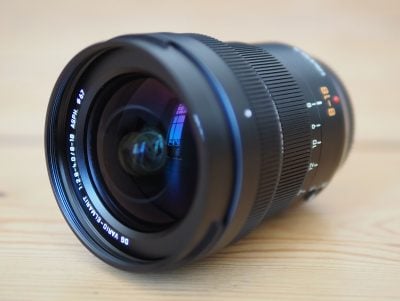Leica DG 8-18mm f2.8-4 review
-
-
Written by Gordon Laing
In depth
The Leica DG Vario Elmarit 8-18mm f2.8-4 is an ultra wide angle zoom for the Micro Four Thirds system. Mounted on a Panasonic or Olympus mirrorless body, it delivers equivalent coverage of 16-36mm, providing a flexible range from modest to ultra-wide.
The 8-18mm is the seventh collaboration between Leica and Panasonic for the Micro Four Thirds system, following the earlier 100-400mm, 12mm f1.4, 15mm f1.7, 42.5mm f1.2, 25mm f1.4 and 45mm f2.8 Macro. Like those models, the 8-18mm is designed and certified by Leica in Germany, and manufactured by Panasonic in Japan. As such it may not be ‘pure’ Leica, but the optical and build quality is of a very high standard.
The Leica 8-18mm also becomes the fourth ultra wide zoom for the Micro Four Thirds system, joining the old Lumix 7-14mm f4 and the Olympus 7-14mm f2.8 and 9-18mm f4-5.6. It employs 15 elements in 10 groups, has seven aperture blades, a closest focusing distance of 23cm, a dust and splashproof body, measures 88x73mm and weighs 315g. In a key advantage over the wider 7-14mm rivals, it’ll also take 67mm filters without vignetting even at 8mm. In my full review below I’ve taken an in-depth look at this new lens, comparing it closely to the existing Lumix 7-14mm f4 and Olympus 7-14mm f2.8 options. If you’re looking for a wide lens for an Olympus or Panasonic body, you’re in the right place! PS – you might also enjoy my Best Micro Four Thirds lenses guide.
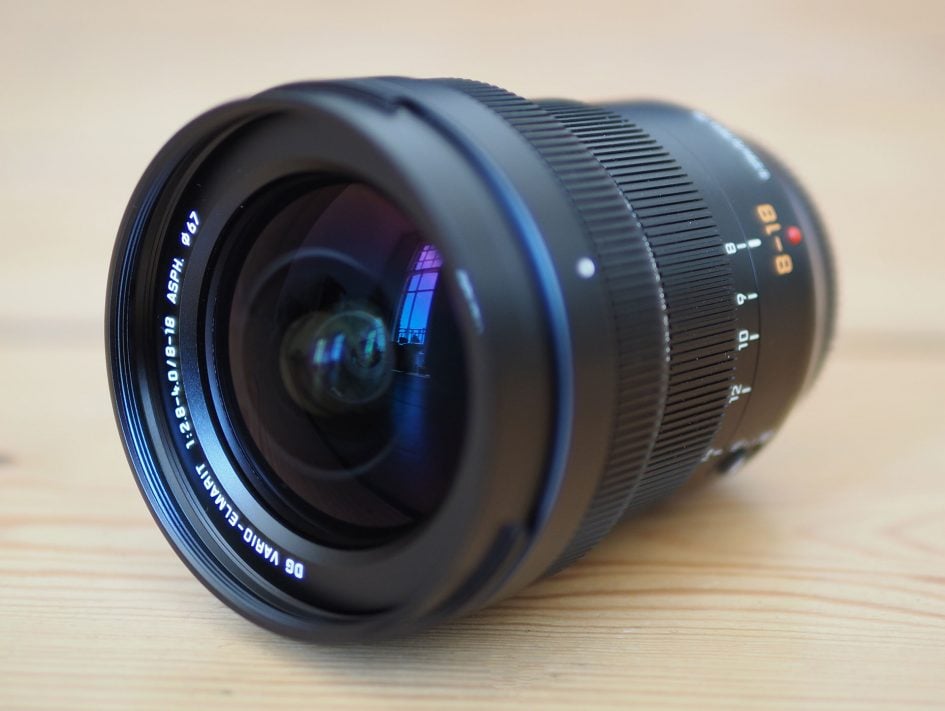
Leica DG 8-18mm design and build quality
The Leica DG 8-18mm f2.8-4 shares a family resemblance with the earlier Panasonic / Leica collaborations with a smart-looking design, higher gloss finish and distinctive Leica font for labeling. Measuring 73mm in maximum diameter, 88mm in length and weighing 315g, it comes across as fairly compact and light for a lens of its class and capabilities.
Comparing it to rival ultra-wide zooms, the Leica 8-18mm is closest to the original Lumix 7-14mm f4, a lens that helped launch the Micro Four Thirds system; on a personal note, it was the presence of an ultra-wide zoom close to launch that initially drew me to adopting MFT. The Lumix 7-14mm is a tad smaller at 70mm in diameter, 83mm in length and a little lighter at 300g in weight, but in your hands and in your bag they’re both in a similar ballpark. Note the Lumix measurements include its built-in lens hood though, whereas mounting the hood on the Leica 8-18mm makes it noticeably larger.
Speaking of larger, the Olympus ZD 7-14mm f2.8 PRO is the heftiest of the group thanks to its constant f2.8 focal ratio. It measures 79mm in diameter, 106mm in length and weighs-in at 534g. While it’s still nowhere near the heft of a full-frame ultra-wide DSLR zoom, it’s still comfortably bigger and heavier than the other options here for Micro Four Thirds and you really notice the difference when it’s mounted on a body. Again like the Lumix 7-14mm, this includes a built-in lens hood.
I’ve pictured these three lenses side-by-side below, from left to right, the Lumix 7-14mm f4, Leica DG 8-18mm f2.8-4, and Olympus ZD 7-14mm f2.8 PRO. It’s clear that while the Lumix 7-14mm is the smallest, the Leica isn’t far behind; meanwhile the Olympus 7-14mm f2.8 is a giant alongside.
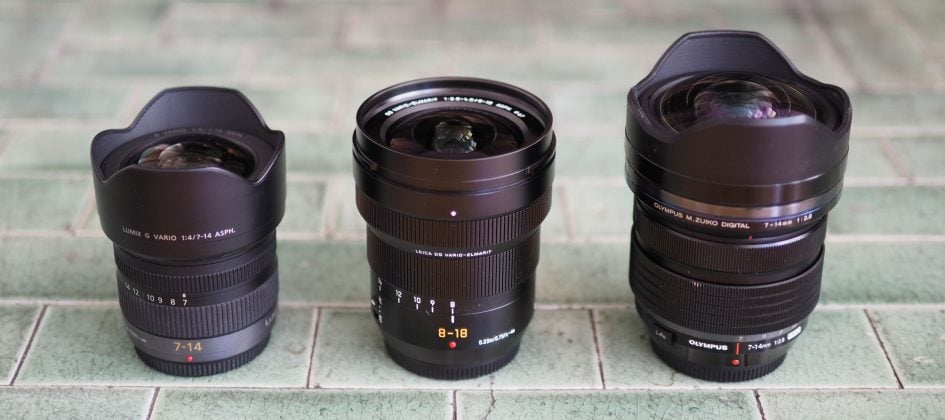
Above: Lumix 7-14mm (left), Leica 8-18mm (middle) and Olympus 7-14mm f2.8 (right)
Meanwhile the smallest of the MFT ultra-wide zooms is the Olympus ZD 9-18mm f4-5.6, at just 57mm in diameter, 50mm in length and only 155g in weight. Coming across more like a compact kit zoom, it’s tiny, but that’s reflected in its comparatively slow focal ratio, along with its overall performance compared to these higher-end lenses. But the sheer fact Micro Four Thirds now offers you four ultra-wide zooms illustrates the maturity and flexibility of the system.
As noted above, the measurements provided for the Leica DG 8-18mm do not include the lens hood, so to place it on a more level playing field with the Lumix 7-14mm and Olympus 7-14mm which both employ built-in hoods, here’s another comparative photo with its supplied hood mounted. The hood transforms the lens into a much larger proposition and while it adds little to the overall weight, the combination does now become closer to the big Olympus in size – something I noticed when accommodating it in my bag.
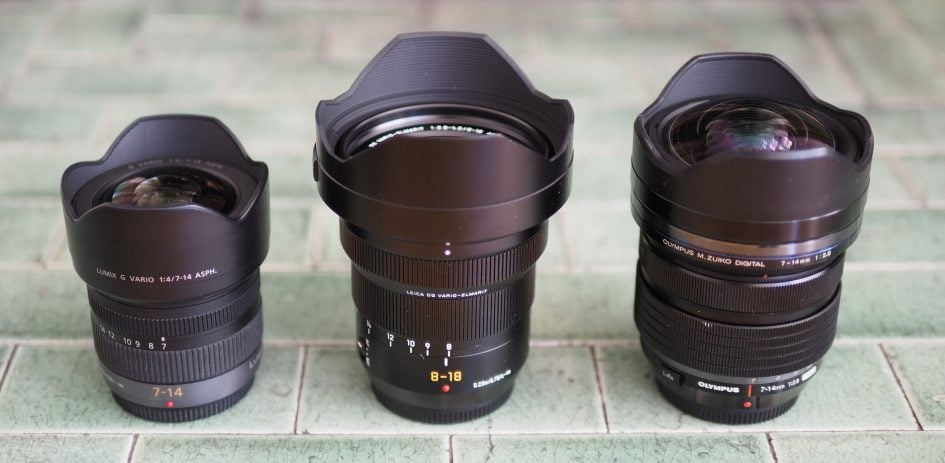
Above: Lumix 7-14mm (left), Leica 8-18mm with hood (middle) and Olympus 7-14mm f2.8 (right)
The difference in hood strategies also means each lens takes a different approach to caps. With its more conventional design, the Leica 8-18mm can employ a standard disc-type lens cap with spring-loaded clips which securely grip the inside of the barrel. With their built-in lens hoods, the Olympus and Lumix 7-14mm both employ more substantial caps which push over the entire end of the hood petals; the Lumix 7-14mm’s cap is held by friction alone, while the larger cap of the Olympus 7-14mm is held by spring-loaded clips. Meanwhile the smaller Olympus 9-18mm uses a simple cap like the Leica 8-18mm.
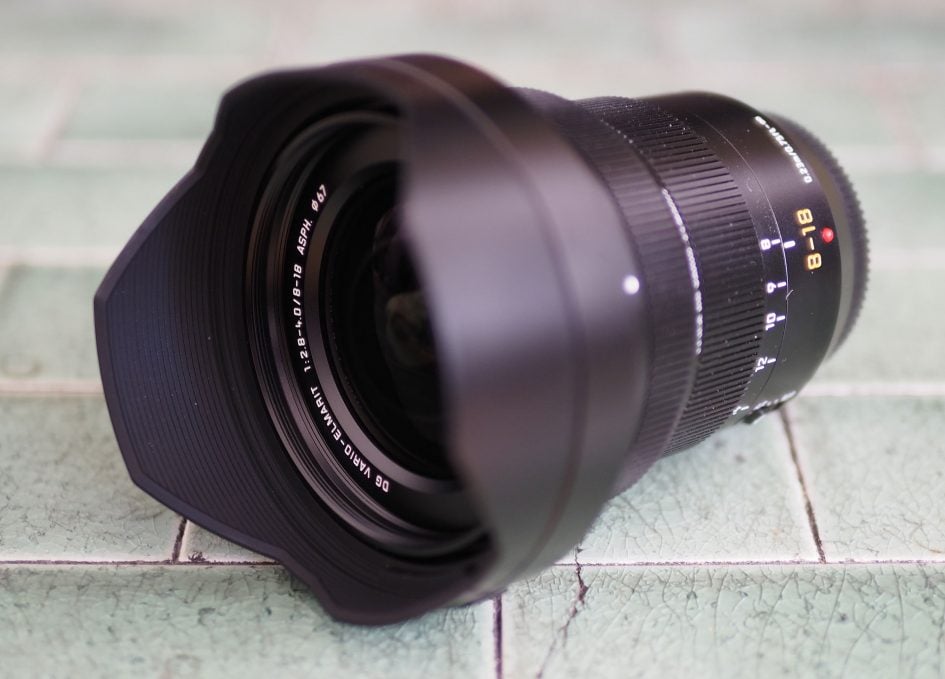
The differences in their respective hoods also impacts their use with filters. The Leica 8-18mm and Olympus 9-18mm both feature standard filter threads measuring 67mm and 52mm respectively, whereas the design of the two 7-14mm lenses means neither can accommodate standard screw-in filters, nor rear-mounted ones either. The absence of a standard thread on the Lumix and Olympus 7-14mm lenses greatly impacts their flexibility if you’re into using neutral density, graduated, polarizer or even simple UV filters. The only way to deploy filters on either of the 7-14mm lenses is to buy into a third-party mounting system and a set of fairly hefty filters to avoid vignetting.
This was always the big advantage of the cheaper Olympus 9-18mm – it may not zoom as wide as the 7-14mm lenses, but the presence of a thread transforms its use with filters. I was delighted when I first discovered the Leica 8-18mm would have a thread, but the question remained how well it would work with filter systems. To put it to the test I mounted my Lee Seven5 filter holder via a 67mm adapter ring and tried out some long exposures at a variety of focal lengths.
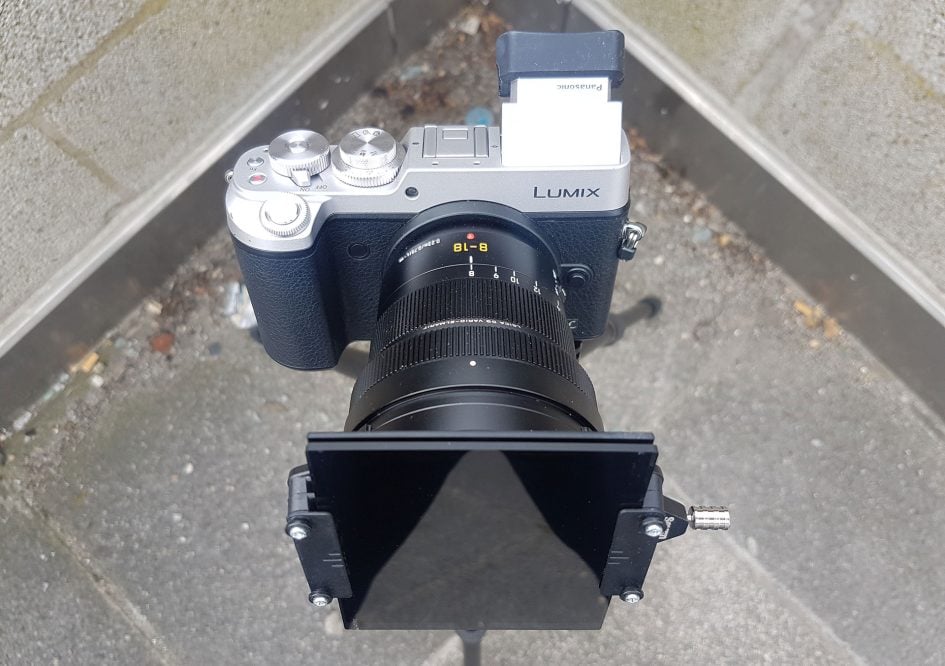
Above: Leica 8-18mm with Lee Seven5 filter holder and two ND filters
While I regularly use this filter system on the Fujifilm XF 10-24mm f4 zoom, I find it vignette below 13mm, preventing me from enjoying the widest coverage available. The solution for this lens is to switch to a larger, less portable and more expensive filter system. I am however both relieved and delighted to report no such issues with the Leica 8-18mm. Due to the optical design and the sensor format, the lens is much less susceptible to vignetting with accessories and I was able to capture images at 8mm with two Lee filters slotted into the holder and no evidence of darkening in the corners. This is great news for lovers of filters and ultra-wide photography: the Leica 8-18mm becomes the widest lens in the Micro Four Thirds system (not to mention many others) which allows you to use a compact but serious filter system at the widest focal lengths without compromise; it’s certainly the one I’d choose for this reason alone. Here’s a shot I took with the Leica 8-18mm at 8mm with two Lee Neutral Density filters and the Seven5 holder.
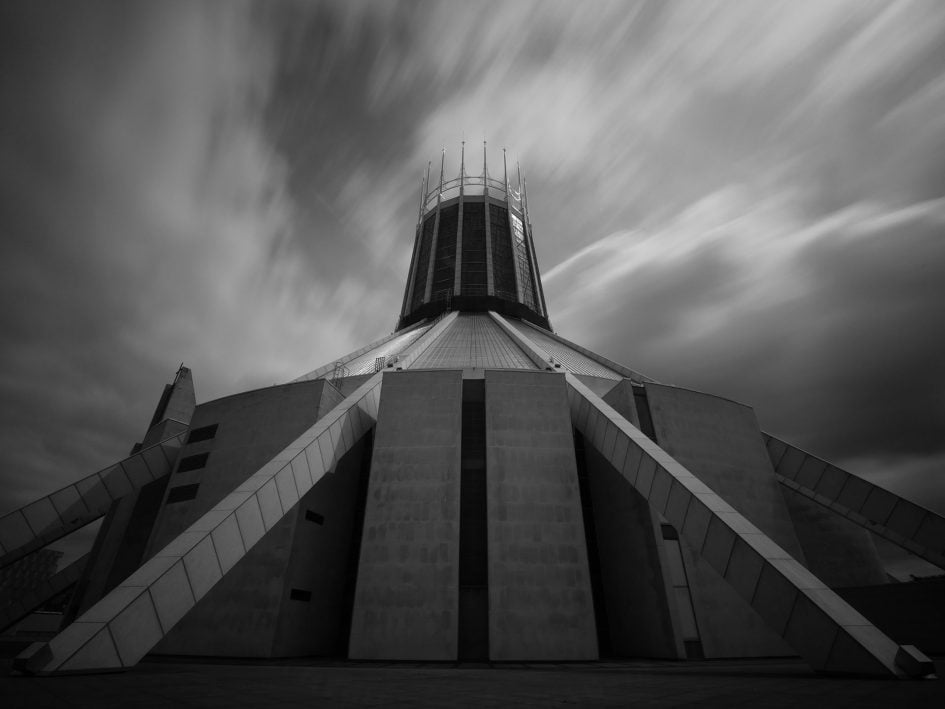
Above: 20 second exposure with Lumix GX8 and Leica 8-18mm at 8mm with Lee Seven5 filter system
Moving onto build quality, the Leica 8-18mm shares a similar approach to the other recent collaborations between them and Panasonic. The barrel is smooth and solidly-assembled, and claims dust and splash-proof construction with a rubber grommet on the lens mount. The Olympus 7-14mm f2.8 PRO feels built to a similar level and also claims environmental sealing, again with a rubber grommet on the lens mount. To find out if one ends up being superior to the other in terms of sealing, we’ll simply have to wait for long-term field reports, but at least they’re both sealed at the lens mount, and both feel physically superior to the Lumix 7-14mm and Olympus 9-18mm lenses.
Like other native lenses in the Micro Four Thirds catalogue, the manual focusing employs a motorized fly-by-wire system where the ring can turn without end-stops; the faster you turn the ring, the greater the increments. To me, the focusing ring on the Leica 8-18mm felt very smooth and nicely damped while avoiding any scratchiness as it turned. The Olympus 7-14mm f2.8 PRO comes close, but I preferred the Leica; meanwhile the Lumix 7-14mm betrays its positioning with a thin and fairly scratchy manual focusing ring which feels more like a kit zoom. Note the Olympus 7-14mm f2.8 PRO’s manual focusing ring does however sport a neat trick where pulling it back towards the camera sets it to a fully manual focus mode with distance markings and hard end-stops.
Like other ultra-wide zooms, the front elements shift in and out as you adjust the focal length, and as such their internal size and weight impacts the feel of the zoom ring. That said, each also employs different degrees of damping. Despite years of use, my Lumix 7-14mm f4’s zoom ring feels stiffest of the three, although to be fair it also has the shortest rotational travel so I’m glad it doesn’t slip from one end to the other too easily.
The zoom ring on the Olympus 7-14mm f2.8 PRO has the heaviest elements to shift and you can feel the difference as you turn it; I also felt more aware of the mechanics and gears within as I turned it on my own sample.
Meanwhile the zoom ring on the Leica 8-18mm felt smoothest of all, and the least stiff of the group – indeed almost strangely light in operation. The bottom line? To me the zoom and manual focusing rings felt best on the Leica 8-18mm, but as always it’s a personal thing and I certainly wouldn’t rule-out the others in this regard.
Leica DG 8-18mm optical construction
In terms of optical construction, the Leica DG 8-18mm employs 15 elements in 10 groups (including one aspherical ED lens, three aspherical lenses, two ED lenses, and one UHR lens). The focal ratio is f2.8 at the short end, f4 at the long-end, and there’s no optical stabilisation, so to iron-out the wobbles you’ll need a body with sensor-shift stabilisation (particularly important for videographers).
The equivalent focal length when mounted on an Olympus or Panasonic body takes you from 16mm to 36mm, or from ultra-wide to general-purpose wide. It’s a really useful range in practice and while it misses out on the slightly wider 7mm (14mm equivalent) of the Lumix 7-14mm and Olympus 7-14mm lenses, I’m happy to sacrifice this for the extra reach at the ‘long’ end. Here’s how the coverage of the Leica 8-18mm looks in practice followed by the Lumix 7-14mm f4 and Olympus 7-14mm f2.8 for comparison.
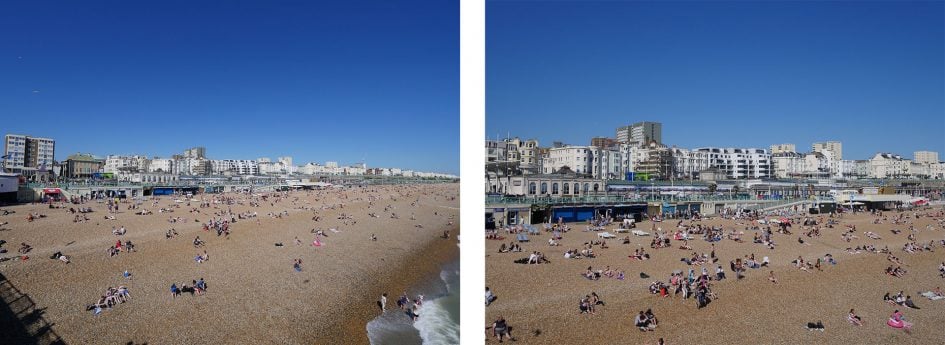
Above: Leica 8-18mm coverage on a Lumix GX8 body. Left at 8mm (16mm equiv), right at 18mm (36mm equiv).
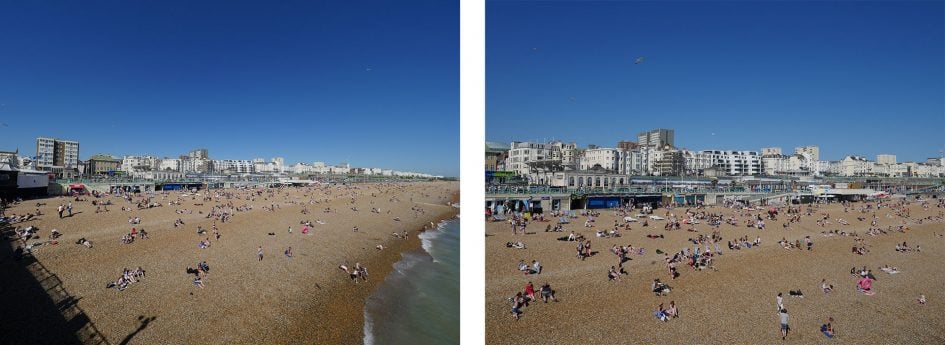
Above: Olympus 7-14mm coverage on a Lumix GX8 body. Left at 7mm (14mm equiv), right at 14mm (28mm equiv).
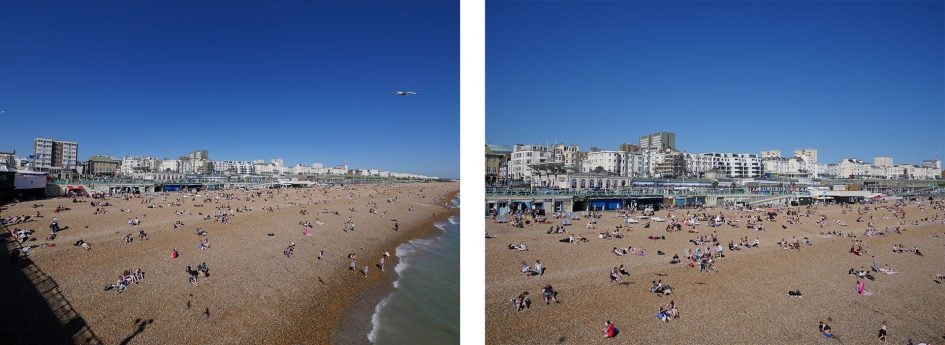 Above: Lumix 7-14mm coverage on a Lumix GX8 body. Left at 7mm (14mm equiv), right at 14mm (28mm equiv).
Above: Lumix 7-14mm coverage on a Lumix GX8 body. Left at 7mm (14mm equiv), right at 14mm (28mm equiv).
Once again, it’s clear from the examples above that while the two 7-14mm zooms are capturing a wider field-of-view at the short-end, the Leica 8-18mm is getting comfortably tighter at the long end. Of course if you don’t mind a reduction in resolution, you could always shoot with the 7-14mm lenses at 14mm and simply crop them to deliver a tighter field-of-view, but if we’re talking about the pure optical ranges of the lenses, I personally feel the 8-18mm (16-36mm equivalent) is more flexible, especially with this particular lens’s ability to easily work with filters. Here’s another example of the 8-18mm range, this time with an interior scene.
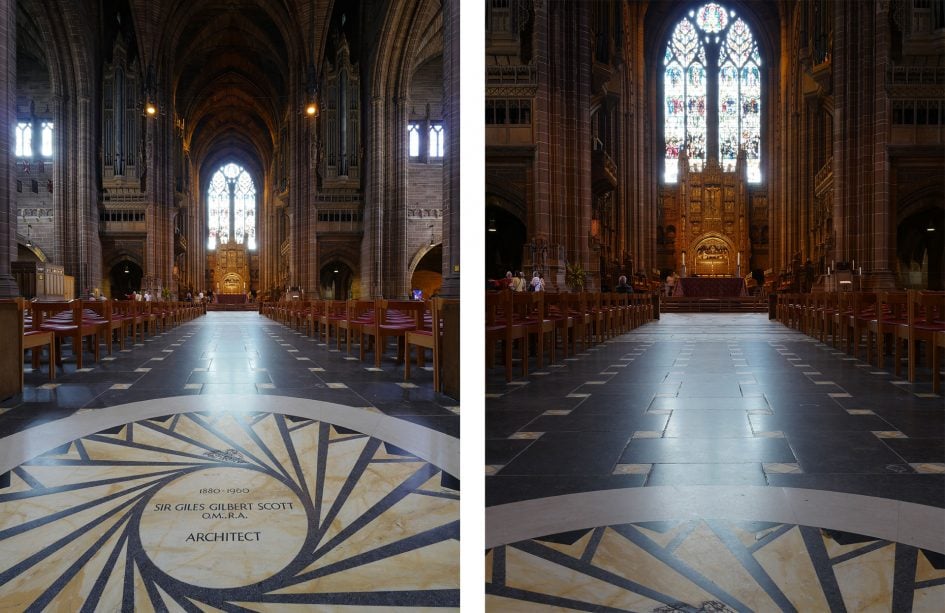
Above: Leica 8-18mm coverage on a Lumix GX8 body. Left at 8mm (16mm equiv), right at 18mm (36mm equiv).
The wide-end is so useful for architecture and landscapes. Here’s some more examples of the lens at 8mm (16mm equivalent) and for more, check out my sample images page.
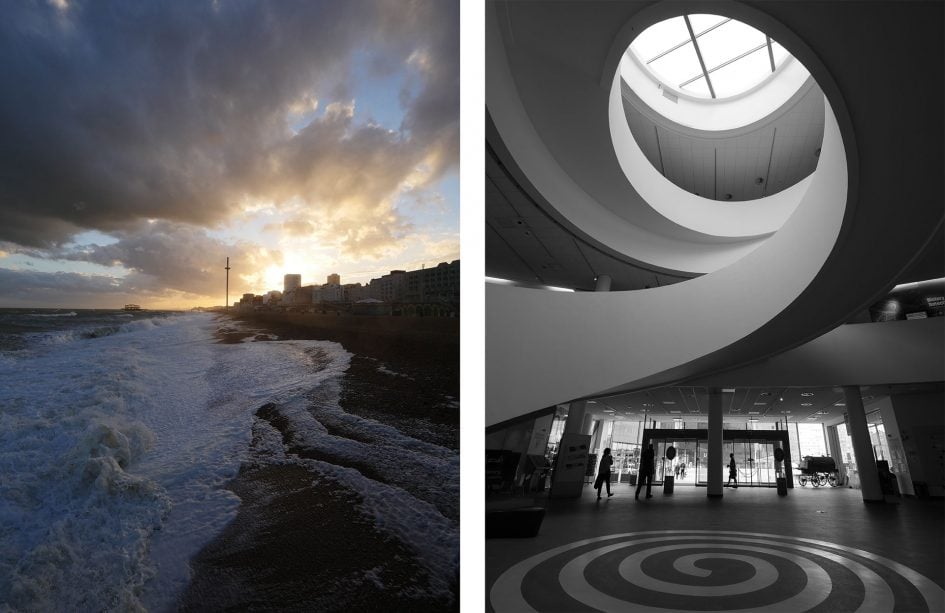
Above: Leica 8-18mm at 8mm (16mm equivalent) on a Lumix GX8 body.
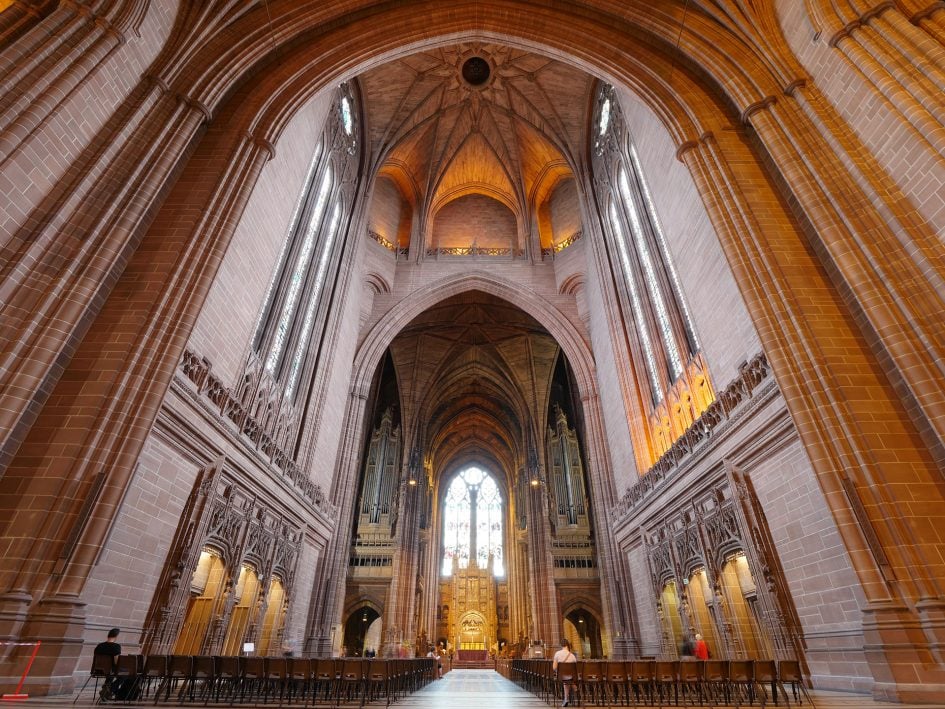
Above: Leica 8-18mm at 8mm (16mm equivalent) on a Lumix GX8 body.
The Leica 8-18mm employs a variable focal ratio, starting at a maximum of f2.8 at 8mm or f4 at 18mm. Many zooms slow-down rapidly as you increase their focal length, but the Leica 8-18mm stays fairly bright for as long as it can. It loses a quarter of a stop to become f3.1 at 9mm (18mm equivalent), half a stop to f3.4 at 12mm, three quarters of a stop to f3.7 at 15mm, before losing the full stop to 4 at 18mm on the nose.
In comparison, the two 7-14mm lenses sport constant focal ratios, f2.8 for the Olympus and f4 for the Lumix. This means the Leica 8-18mm starts out sharing the same focal ratio as the Olympus 7-14mm at the wide-end, but gradually loses a stop as it zooms-in. In contrast, the Leica starts-off one stop brighter than the Lumix 7-14mm at the wider-end, but gradually matches it as it reaches the longer-end.
Personally I think the Leica design has got the balance right. It’s got the brighter focal ratio where it needs it at the wide-end, which will be appreciated by astro-photographers. Meanwhile it may slow-down by a stop at the longer-end compared to the Olympus 7-14mm, but at this focal length it won’t make a significant difference to the depth-of-field, nor your ability to handhold at low ISOs thanks to the excellent stabilisation built-into the latest Panasonic and Olympus bodies. More importantly the variable focal ratio allows the Leica 8-18mm to come in at a noticeably smaller size, lighter weight and slightly cheaper price too. Put it this way, I prefer the size, weight, price, coverage and filter mounting benefits of the Leica 8-18mm over the slightly wider short-end and brighter focal ratio of the Olympus 7-14mm.
As always, if you do want to minimise the depth-of-field, it helps if you can focus close to your subject. The Leica 8-18mm has a closest focusing distance of 23cm throughout the zoom range; this slightly beats the 25cm of the Lumix 7-14mm and Olympus 9-18mm, but is slightly beaten by the 20cm of the Olympus 7-14mm f2.8. Numbers aside, what does this mean in practice? Here’s two shots taken at the closest focusing distance and maximum aperture of the Leica 8-18mm, first at 8mm, then at 18mm. Thanks as always to the wonderful Bison Beer in Brighton for letting me shoot in there!

Above: Leica 8-18mm at 8mm f2.8 and at closest focusing distance.

Above: Leica 8-18mm at 18mm f4 and at closest focusing distance.
It’s not just the maximum aperture that’s of interest. Close the aperture down and you can enjoy diffraction effects that transform point sources of light into spiked shapes. The minimum aperture of the Leica 8-18mm is f22 and here’s how it looks when pointed directly at the Sun at 8mm (left) and 18mm (right), both shot at f22. You can see the 14 spikes generated through diffraction by the seven aperture blades; they’re rounded blades, but you can still get a reasonable spike effect. Note there was a little haze in the sky, so the effect you see here isn’t as crisp as you might achieve with clearer skies or with more defined artificial point sources of light.
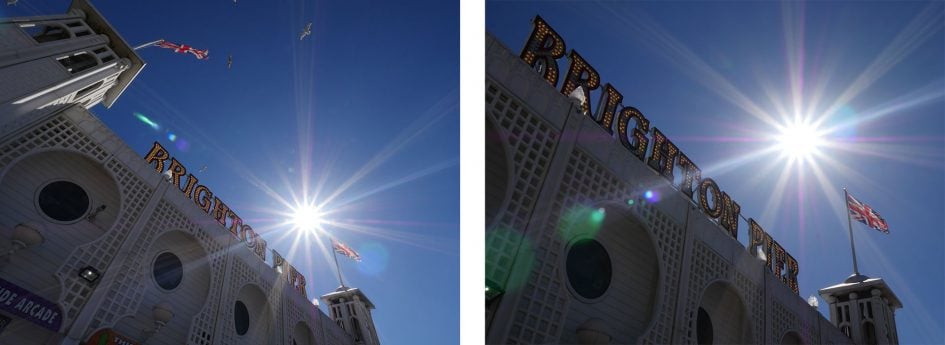
Above: Diffraction spikes with the Leica 8-18mm at f22. Left at 8mm, right at 18mm.
Diffraction spikes can also produce an attractive effect with artificial lighting, so to compare the Leica 8-18mm against its rivals, I shot the interior of Liverpool Cathedral with it and the Olympus 7-14mm f2.8 and Lumix 7-14mm, all set to 8mm f22 on the Lumix GX8.
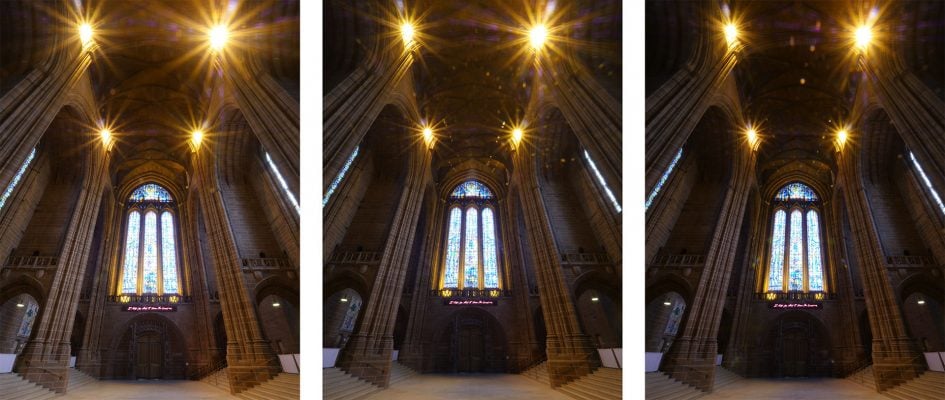
Above left to right: Leica 8-18mm, Olympus 7-14mm and Lumix 7-14mm, all at 8mm f22.
Each of the three lenses above uses seven aperture blades, which in turn deliver the 14 diffraction spikes around bright point sources of light. Of the three, I personally think the Olympus 7-14mm f2.8 (above middle) is producing the sharpest and most attractive spikes, although the Leica 8-18mm (above left) is close behind. Meanwhile the older Lumix 7-14mm (above right) is looking less defined in comparison. Note the large number of artefacts on each image, due to a combination of the optical design, the sensor and the cleanliness of the entire system. For the cleanest spikes at small apertures you have to keep both the sensor and optics meticulously clean, and also learn what kind of situations and angles might trigger flare with a particular lens. None of the three here are immune to artefacts when pointed directly at bright lights, but I should admit the front elements weren’t as clean as they could be.
Staying on the subject of coloured flare artefacts, I was also keen to see if the Leica 8-18mm would suffer from the purple flare / blob issue which can plague the Lumix 7-14mm under some situations. These are most obvious when shooting subjects with very high contrast between light and dark, such as bright lights against a dark wall or ceiling, a subject against a bright overcast sky, or a window shot from inside looking out to a bright day. Interestingly they become most visible when mounted on an Olympus body, although I’ve also seen them on Lumix bodies, just in a less vibrant blue.
To find out if the Leica 8-18mm suffered from the same issues, I found a scene which noticeably triggered them on the Lumix 7-14mm and shot it with both lenses set to 8mm and mounted on an Olympus OMD EM1 Mark I; I’ve pictured the Leica 8-18mm on the left and the Lumix 7-14mm on the right below and it’s clear how the Leica avoids the purple flare that’s quite visible on the Lumix shot. Just for reference I also repeated the shot with the Olympus 7-14mm f2.8 and found it too managed to avoid the flare issue of the Lumix 7-14mm. I should also add the flare issue on the Lumix 7-14mm isn’t resolved by closing the aperture and or adjusting the zoom – it’s frustratingly always there if you shoot certain very high contrast subjects.
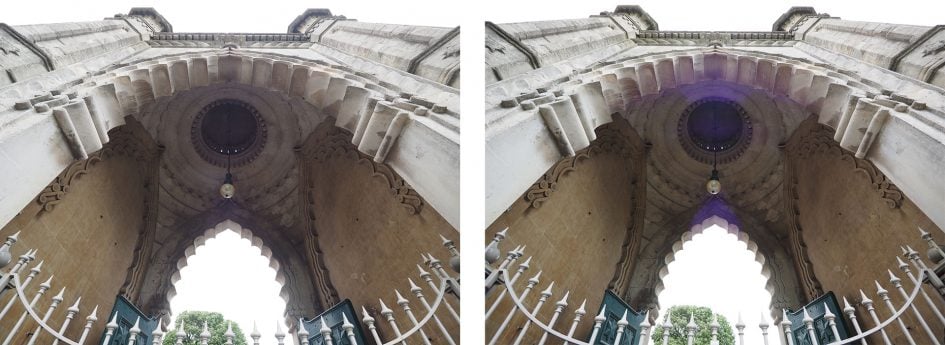
Above left: Leica 8-18mm at 8mm. Above right: Lumix 7-14mm at 8mm.
The reduced purple flare on the Leica 8-18mm in situations where it’s a problem on the Lumix 7-14mm is another important upgrade for owners of that older lens. That said, the Leica 8-18mm isn’t completely immune to flare issues as seen in the cathedral comparison earlier. Here’s another form the same location pointing in the opposite direction where you can see the full image below left and a 100% crop below right of the left window. There’s evidence of some coloured flare by the high contrast window, but it’s nowhere near as bad as the Lumix 7-14mm would have been.
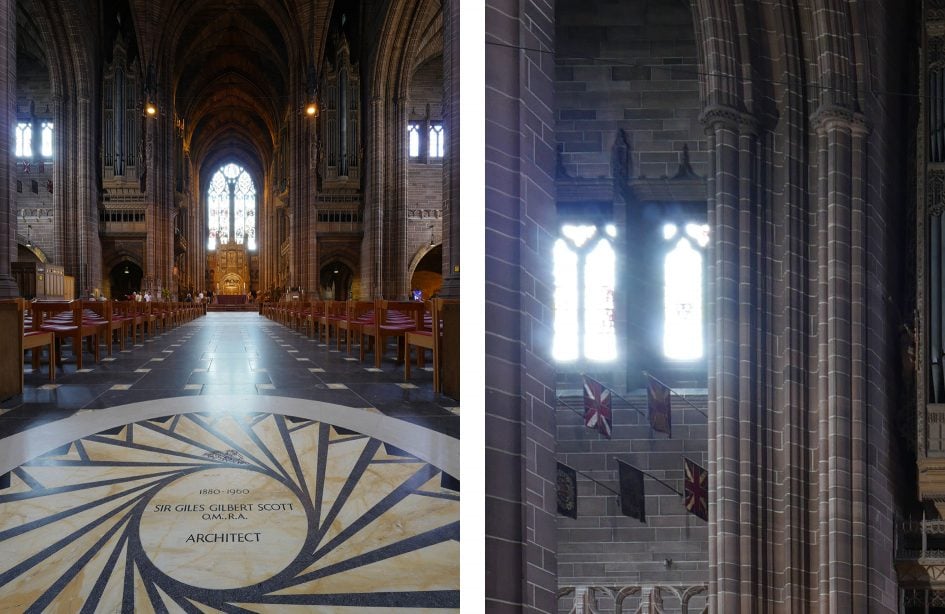
Above: Leica 8-18mm at 8mm. Full image on left, cropped region on right.
Before moving-on, a quick look at vignetting and geometry. Starting with vignetting, there’s some darkening in the corners at 8mm f2.8, but it’s not significant and it’s also easy to correct; close the aperture to f4 and it’s virtually gone. Meanwhile at the long-end there’s minimal vignetting wide-open at 18mm f4, and again close the aperture by a stop and it’s essentially gone.

Above: Lecia 8-18mm vignetting at 8mm. From left to right, at f2.8, f4 and f5.6.
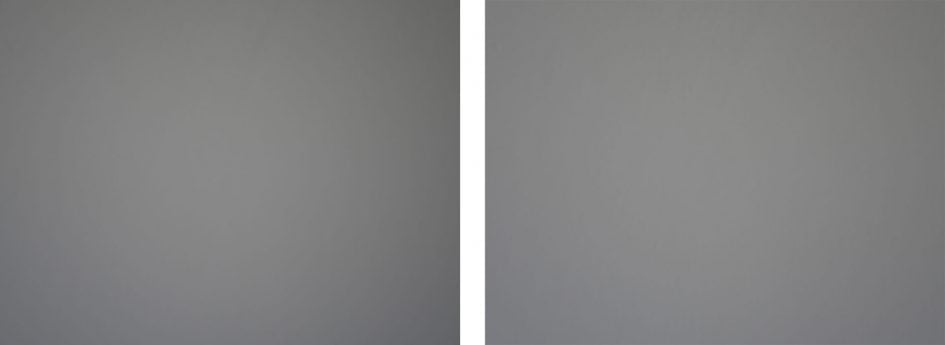
Above: Lecia 8-18mm vignetting at 18mm. Left at f4, right at f5.6.
In terms of geometry, there’s inevitably some barrel distortion at the wide-end of the range, but it’s remarkably minor and generally well-behaved throughout the range. Certainly throughout my tests and sample images, there’s little evidence of the distortion that’s often apparent on ultra-wide lenses.
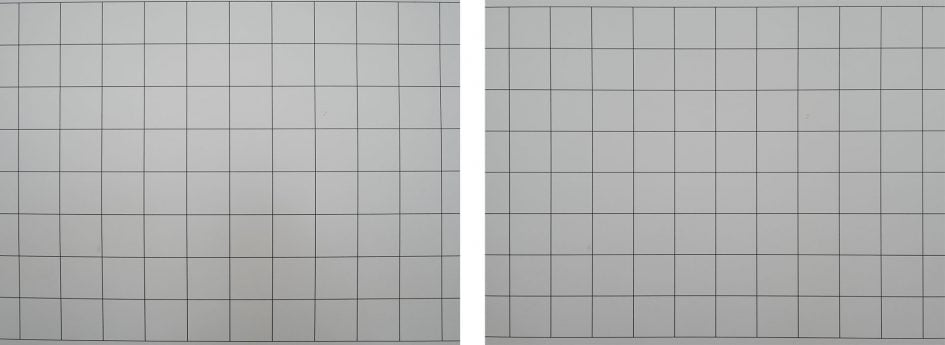
Above: Leica 8-18mm geometry at 8mm left and 18mm right.
Keep reading for my final verdict, or if you’d like more detail, check out my quality and sample images pages!
Leica DG 8-18mm f2.8-4 verdict
The Leica DG 8-18mm f2.8-4 becomes the fourth ultra-wide zoom for the Micro Four Thirds system, and arguably the most compelling overall to date. It may not zoom quite as wide as the Lumix and Olympus 7-14mm models, but the extra reach at the longer end makes it more flexible, and crucially the ability to mount standard (or even serious ND) filters without vignetting will be appreciated by many (especially long exposure) photographers. The Leica may not be quite as sharp in the corners as the Olympus 7-14mm at wide apertures and it also lacks the constant f2.8 focal ratio, but in turn it’s smaller, lighter and cheaper. It also out-performs the older Lumix 7-14mm f4, while mostly avoiding the purple flare issues of that model. Throw in quick and quiet focusing, and a weather-sealed body with smooth focus and zoom rings and you have a lens that’s easy to highly recommend. It’s become my favourite ultra-wide zoom for Panasonic and Olympus bodies, and a tempting upgrade for owners of the Lumix 7-14mm f4 or Olympus 9-18mm.
Check prices on the Leica DG 8-18mm f2.8-4 at Amazon, B&H, Adorama, or Wex. Alternatively get yourself a copy of my In Camera book or treat me to a coffee! Thanks!
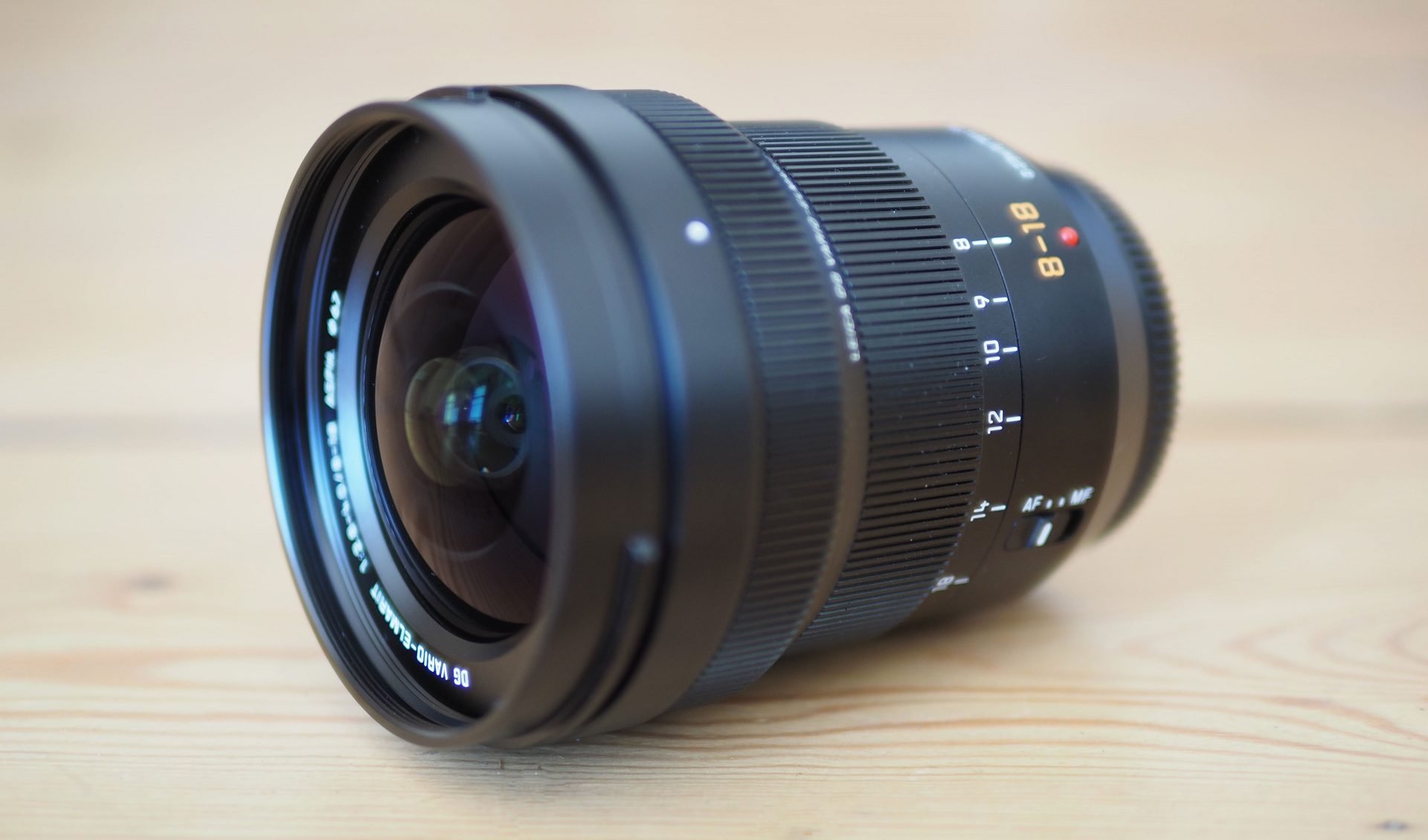
 The Leica DG 8-18mm f2.8-4 becomes the fourth ultra-wide zoom for the Micro Four Thirds system, and arguably the most compelling overall to date. It may not zoom quite as wide as the Lumix and Olympus 7-14mm models, but the extra reach at the longer end makes it more flexible, and crucially the ability to mount standard (or even serious ND) filters without vignetting will be appreciated by many (especially long exposure) photographers. The Leica may not be quite as sharp in the corners as the Olympus 7-14mm at wide apertures and it also lacks the constant f2.8 focal ratio, but in turn it's smaller, lighter and cheaper. It also out-performs the older Lumix 7-14mm f4, while mostly avoiding the purple flare issues of that model. Throw in quick and quiet focusing, and a weather-sealed body with smooth focus and zoom rings and you have a lens that's easy to highly recommend. It's become my favourite ultra-wide zoom for Panasonic and Olympus bodies, and a tempting upgrade for owners of the Lumix 7-14mm f4 or Olympus 9-18mm.
The Leica DG 8-18mm f2.8-4 becomes the fourth ultra-wide zoom for the Micro Four Thirds system, and arguably the most compelling overall to date. It may not zoom quite as wide as the Lumix and Olympus 7-14mm models, but the extra reach at the longer end makes it more flexible, and crucially the ability to mount standard (or even serious ND) filters without vignetting will be appreciated by many (especially long exposure) photographers. The Leica may not be quite as sharp in the corners as the Olympus 7-14mm at wide apertures and it also lacks the constant f2.8 focal ratio, but in turn it's smaller, lighter and cheaper. It also out-performs the older Lumix 7-14mm f4, while mostly avoiding the purple flare issues of that model. Throw in quick and quiet focusing, and a weather-sealed body with smooth focus and zoom rings and you have a lens that's easy to highly recommend. It's become my favourite ultra-wide zoom for Panasonic and Olympus bodies, and a tempting upgrade for owners of the Lumix 7-14mm f4 or Olympus 9-18mm.



